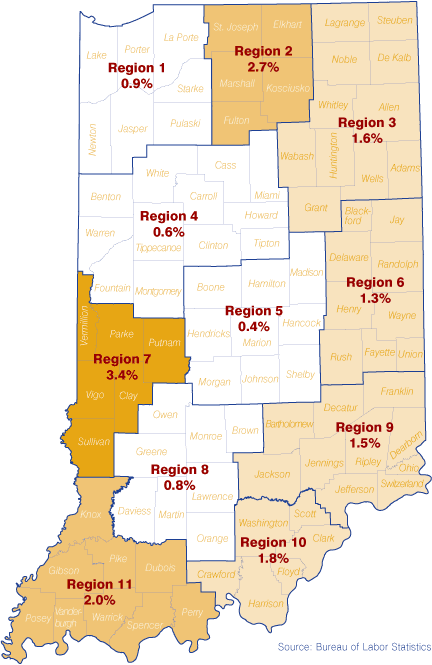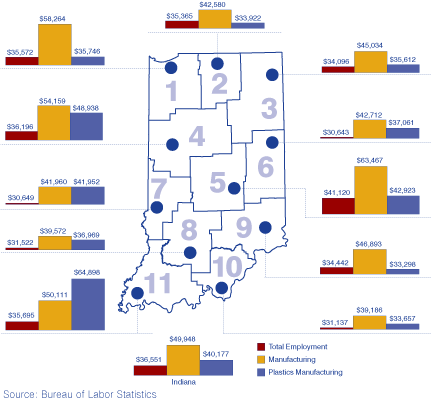Plastics are Big Business in Indiana
The world's first entirely synthetic material turned 100 this year. In 1907, Leo Baekeland developed a phenol-formaldehyde polymer resin. “Although scientists had long tinkered with different types of plastics, so-called because of their malleability, his was the first fully synthetic material ever made.” (1)
A century later, plastics are increasingly used as a substitute for rubber. The plastics industry produces finished products, such as packaging materials, piping, bags, bottles, bowls, cups, dinnerware, polystyrene foam products, urethane foam products, siding material and resilient floor coverings, along with plate, sheet and rod plastic used as “inputs” for additional manufacturing. Plastics product manufacturing is primarily engaged in processing new or recycled plastics resins into products using compression molding, extrusion molding, injections molding, blow molding and casting.
Plastics product manufacturing in Indiana grew 22 percent between 1990 and 2006. Meanwhile, the U.S. growth was 3.1 percent according to Current Employment Statistics.
In 2005, manufacturing in Indiana was 19.9 percent of total employment while manufacturing in the United States was 10.8 percent of total employment. In Indiana, 6.2 percent of manufacturing employment is in plastics product manufacturing, compared to just 4.5 percent in the United States overall.
Location quotients are ratios that allow an area's distribution of employment by industry to be compared to a reference or base area's distribution. If a location quotient is equal to 1, then the industry has the same share of its area employment as it does in the reference area. A location quotient greater than 1 indicates an industry with a greater share of the local area employment than is the case in the reference area. Indiana's manufacturing location quotient was 1.8, while the plastics industry in Indiana has a location quotient of 1.4.
Plastics product manufacturing varies throughout the state from a low of 2 percent of manufacturing employment (0.6 percent of total employment) in Economic Growth Region (EGR) 4 to a high of 18.6 percent of manufacturing employment (3.4 percent of total employment) in EGR 7 (see Table 1 and Figure 1). Southwest Indiana, northwest Kentucky and southeast Illinois area has called itself the “plastics valley” for years. EGR 11 does rank third in plastics employment as a percent of manufacturing employment for the Indiana regions, corroborating this assertion.
Table 1: Plastics Manufacturing Employment Annual Average, 2006
| EGR | Plastics Manufacturing Employment |
Percent of Region's Manufacturing Employment |
| 7 | 2,864 | 18.6 |
| 10 | 1,879 | 9.2 |
| 11 | 4,079 | 9.1 |
| 2 | 8,528 | 8.0 |
| 3 | 5,595 | 6.4 |
| 6 | 1,652 | 6.3 |
| 1 | 2,920 | 5.8 |
| 9 | 2,035 | 5.3 |
| 8 | 923 | 5.2 |
| 5 | 3,705 | 3.6 |
| 4 | 1,113 | 2.0 |
Figure 1: Plastics Employment as a Percent of Total Regional Covered Employment, 2006

Plastics companies vary in size from less than five employees to over 1,000 employees. Eight plastics manufacturing companies in the state employ over 500 workers and EGR 11 has three of them. (2)
As for wages, manufacturing employment in general is known for having higher wages than other industries. Plastics products manufacturing wages were higher than average wages in all areas except EGR 2 and EGR 9 (see Figure 2). However, only in EGR 11 was the plastics product manufacturing wage average higher than the manufacturing wage.
Figure 2: Plastics Products Manufacturing Average Annual Wages, 2006
Many other manufacturing activities use plastics to make everything from footwear to furniture to automobiles. Typically, the production process of these products involves more than one material, so they are not classified in plastics products manufacturing sector because the core technologies for these activities are diverse.
"Plastics." That was the simple career advice offered to Dustin Hoffman's character in the 1967 film, The Graduate, and this analysis suggests that plastics remain an important part of the economy.
Notes
- Raphael G. Satter, “Happy Birthday! Plastic turns 100,” Evansville Courier and Press, May 23, 2007.
- Info USA, Hoosiers by the Numbers website.
Cathy Boatman, Research and Analysis Department
Advanced Economic and Market Analysis Group, Indiana Department of Workforce Development

